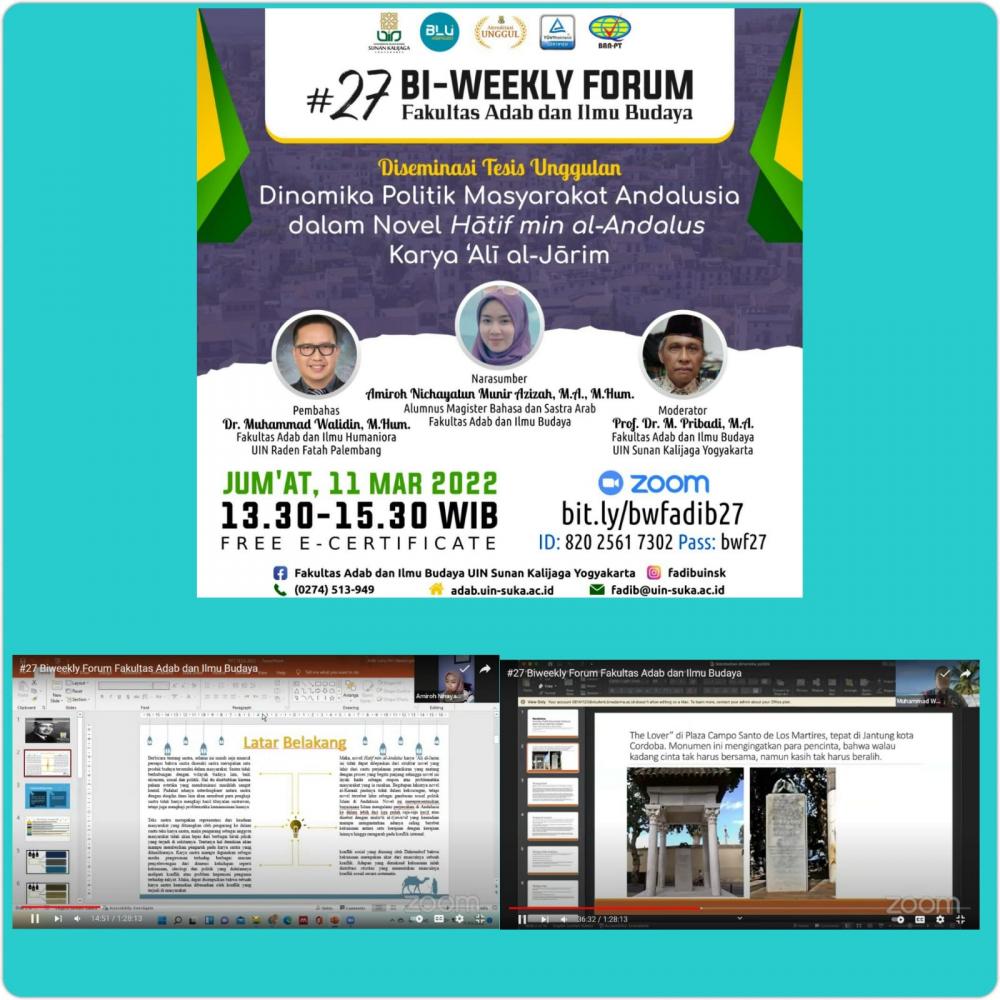The Dynamics of Politics in Andalusia in a Novel: Discussing Hatif min al-Andalus by Ali al-Jarim

The Dynamics of Politics in Andalusia in a Novel: Discussing Hatif min al-Andalus by Ali al-Jarim
Ali al-Jarim is an Arabic linguist and Egyptian writer. Hatif min al-Andalus is one of his novels that illustrated the history of Islam in Andalusia (now Spain). To discuss the novel, Bi-Weekly Forum #27 Faculty of Adab and Cultural Sciences UIN Sunan Kalijaga held a virtual seminar entitled "Political Dynamics of Andalusian Society in the Novel Hatif min al-Andalus by Ali al-Jarim". The speaker, Amiroh Nichayatun Munir Azizah, M.A., M.Hum., is an alumnus of Magister Program of Arabic Language and Literature of the Faculty of Adab and Cultural Sciences, UIN Sunan Kalijaga. The discussion held on Friday, March 11, 2022, was moderated by Prof. Dr. M. Pribadi, M.A.
To begin with, Amiroh explains Ali al-Jarim's profile and background. Al-Jarim was born in Rashid, Egypt, in 1881. He lived in an atmosphere where Egyptian Muslim writers emerged, such as Ahmad Syauqi, Thaha Husein, Mahmud Fahmi, and others. This circumstance gave contribution and influence to Al-Jarim's thinking. The novel itself illustrates the social and political dynamics in Andalusian Society in the 10th AD century.
Moreover, it explores a small number of social and political conflicts such as Zaitun and Ibn Abdus, the kingdom of Cordova and the kingdom of Seville, the government of Ibn Jahwar, and the people of Andalusia as well as Abu Walid and Ibn Zaitun. To understand the novel, Amiroh used Dahrendorf's conflict theory, which states that the basis of class conflict was the division of three groups of society: quasi groups, interest groups, and conflict groups. Thus, society can be split into the "command class" and the "obey class".
In addition, Amiroh states that Al-Jarimi used a historical realism writing style in this novel. It centered on historical events and periods of Islam in Andalusia. This novel reminds readers how Muslim rulers easily spread in various cities in Andalusia for eight centuries (711-1492). According to Amiroh, this novel just focused on Andalusia during the last period of the Muawiyah Dynasty in Andalusia that separated became approximately 30 small kingdoms and was well-known as Muluk at-Tawaif. The writer, Ali al-Jarimi, has never been to Spain, but he could write a novel about Andalusia. It is possible that he also read a lot of sources about the history of Islam in Andalusia. This work also reminds the Egyptian people about their government leaders. At that time, Egypt was closer to monarchy than democracy.
